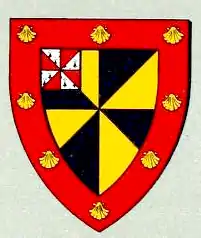Sir Hugh Campbell
Sir Hugh Campbell of Cesnock in Ayrshire was a 17th-century baronet of Cessnock. His lineage was from the Campbells of Loudoun.[1]
Hugh Campbell | |
|---|---|
| Title | Baronet of Cessnock |
| Personal | |
| Born | March 1615 Cessnock, Ayrshire |
| Died | 20 September 1686 Edinburgh |
| Resting place | Greyfriars Kirkyard |
| Religion | Christianity |
| School | Presbyterianism |

Sir Hugh was the MP for Ayrshire in the Parliament of Scotland from 1639 to 1641 and again from 1645 to 1647 and from 1649 to 1650. He was appointed to, but turned down, the posts of Lord Justice Clerk and Lord of Session by the Scottish Parliament in 1649. He was succeeded by Sir George Campbell of Cessnock, his son.[2]
He was reportedly arrested after the Battle of Rullion Green in 1666.[3] His house was in Galston.
He was tried for high treason in March 1684 for being part of the rising at Bothwell Bridge. A not proven verdict was returned but nevertheless he and his son were imprisoned on the Bass Rock on the Firth of Forth in Haddingtonshire.[4] The order for his transport from the Tolbooth is dated 15 September 1684. It apparently took about 4 days to put into effect.[5] He was sent at the same time as John Rae but neither Rae nor Hugh's son Sir George Campbell were permitted to ride in a coach or on a horse someone provided.[6][7]
In 1685 Hugh and his son were accused of accession to the Rye House Plot. This was a plot for the assassination of Charles II. and the elevation of his illegitimate son, by Lucy Walters, the Duke of Monmouth, to the throne. Although the proof failed, Parliament adjudged them guilty. Their lives were spared, but an act of attainder was taken out against them, by which their lands passed to the Crown and themselves again committed prisoners to the Bass.[8] On 13 June 1685 notice of his forfeiture and that of his son were recorded.[9] Both Campbells were released on 6 August 1685 but later re-arrested.[10]
He was released from the Bass to die in Edinburgh and was buried in Greyfriars Kirkyard on 23 September 1686.[11]
References
- G. Harvey Johnston, The Heraldry of the Campbells, vol. II (1921) p. 59.
- "Sir Hugh Campbell, of Cessnock, Baronet Male 1615 - 1686 (~ 71 years)". Clan MacFarlane and associated clans genealogy. Retrieved 11 February 2019.
- Orr, Brian J. "Campbell of Cessnock". The Reformation. Retrieved 13 February 2019.
- M'Crie, Thomas, D.D. the younger (1847). The Bass rock: Its civil and ecclesiastic history. Edinburgh: J. Greig & Son. pp. 371–372. Retrieved 11 February 2019.
- Fairley, John A (1916). The book of the Old Edinburgh Club. 9. Edinburgh: The Club. p. 155. Retrieved 16 March 2019.
- Erskine, John; Macleod, Walter (1893). Journal of the Hon. John Erskine of Carnock, 1683-1687. Edinburgh: Printed at University press by T. and A. Constable for the Scottish history society. p. 84. Retrieved 16 February 2019.
- Paton, Henry, ed. (1929). The Register of the Privy Council of Scotland. 9 (The Register Of The Privy Council Of Scotland Edited And Abridged By Henry Paton, M.A., With An Introduction By Robert Kerr Hannay, Ll.D., Fraser Professor Of Scottish History And Palaeography In The University Of Edinburgh. Third Series, Vol. IX. A.D. 1685–1686. ed.). Edinburgh: H.M. General Register House. pp. 175–178. Retrieved 9 March 2019.
- Dickson, John (1899). Emeralds chased in Gold; or, the Islands of the Forth: their story, ancient and modern. [With illustrations.]. Edinburgh and London: Oliphant, Anderson & Ferrier. pp. 204–205. Retrieved 3 March 2019.
 This article incorporates text from this source, which is in the public domain.
This article incorporates text from this source, which is in the public domain. - Brown, K.M. et al eds. Decreet of forfeiture against Sir Hugh and Sir George Campbell of Cessnock (James VII: Translation > 1685, 23 April, Edinburgh, Parliament > Additional Sources > 13 June 1685 ed.). The Records of the Parliaments of Scotland to 1707, (St Andrews, 2007-2019). Retrieved 11 February 2019.CS1 maint: extra text: authors list (link)
- Laing, David (1848). Historical Notices of Scotish Affairs: Selected from the Manuscripts of Sir John Lauder of Fountainhall. 2. Edinburgh: T. Constable, printer to Her Majesty. p. 660. Retrieved 17 April 2019.CS1 maint: ref=harv (link)
- Greaves, Richard L. (2004). "Campbell, Sir Hugh, of Cessnock". Oxford Dictionary of National Biography (online ed.). Oxford University Press. doi:10.1093/ref:odnb/67246. (Subscription or UK public library membership required.)
